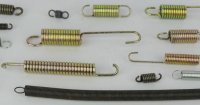模具弹簧是一种常见的弹性元件,在许多行业中得到广泛应用。它们具有良好的弹性和承载能力,可以用于机械装置、汽车、电子设备等多个领域。然而,模具弹簧的拉伸方向对其性能和使用寿命有着重要的影响。
模具弹簧的拉伸方向
模具弹簧的拉伸方向是指加载弹簧时施加力的方向,它决定了弹簧的形状、弹性和承载能力。在设计和制造模具弹簧时,拉伸方向需要被仔细考虑。
通常情况下,模具弹簧的拉伸方向可以分为水平方向和垂直方向。水平方向的拉伸是指施加力与弹簧弹性方向平行,垂直方向的拉伸是指施加力与弹簧弹性方向垂直。
拉伸方向对模具弹簧的影响
1. 强度和刚度:模具弹簧在不同的拉伸方向下,其强度和刚度表现出不同的特点。水平拉伸方向下,弹簧的刚度较高,能够承受较大的力。而垂直拉伸方向下,弹簧的刚度较低,能够提供更好的缓冲和减震效果。
2. 弹性变形:拉伸方向也会影响模具弹簧的弹性变形行为。在水平拉伸方向下,弹簧相对刚性,弹性变形较小。而在垂直拉伸方向下,弹簧相对柔软,能够更好地适应不同的载荷条件。
3. 负载能力:模具弹簧的拉伸方向还会影响其负载能力。在水平拉伸方向下,弹簧能够承受较大的负载,适用于需要提供大扭矩或压缩力的场合。而在垂直拉伸方向下,弹簧的负载能力较低,适用于需要提供缓冲和减震效果的场合。
模具弹簧拉伸方向的选择
在选择模具弹簧的拉伸方向时,需要根据具体的应用需求和力学性能进行分析和判断。
1. 功能需求:首先需要明确弹簧在应用中需要提供的功能,是承受大力、提供缓冲和减震效果,还是需要兼顾两者。根据功能需求,选择合适的拉伸方向。
2. 空间约束:模具弹簧的安装空间限制也会影响拉伸方向的选择。有时候,由于空间狭小或其他因素,只能选择特定的拉伸方向。
3. 载荷类型:不同的载荷类型对模具弹簧的拉伸方向有不同的要求。例如,扭矩载荷通常需要水平拉伸方向,而冲击载荷通常需要垂直拉伸方向。
综上所述,模具弹簧的拉伸方向对其性能和使用寿命有着重要的影响。在选择和设计模具弹簧时,需要根据应用需求和力学性能综合考虑,选择合适的拉伸方向。
为了更好地利用模具弹簧的特性,设计和制造人员需要对模具弹簧的拉伸方向有深入的了解,并根据具体情况进行合理选择。
希望本文对模具弹簧的拉伸方向选择提供了一些帮助,如果您还有其他相关问题,欢迎随时与我们联系。
Translated (English): htmlMold springs are commonly used elastic elements that find widespread applications in various industries. They possess good elasticity and load-bearing capacity, making them suitable for use in mechanical devices, automobiles, electronic equipment, and more. However, the direction of tension for mold springs has a significant impact on their performance and service life.
The Direction of Tension for Mold Springs
The direction of tension for mold springs refers to the direction in which the force is applied when loading the spring. It determines the shape, elasticity, and load-bearing capacity of the spring. When designing and manufacturing mold springs, the direction of tension needs to be carefully considered.
Typically, the direction of tension for mold springs can be divided into horizontal and vertical directions. Horizontal tension refers to applying force parallel to the spring's elastic direction, while vertical tension refers to applying force perpendicular to the spring's elastic direction.
The Impact of Tension Direction on Mold Springs
1. Strength and Stiffness: Mold springs exhibit different characteristics of strength and stiffness under different tension directions. In the horizontal tension direction, the spring has higher stiffness and can withstand larger forces. In contrast, in the vertical tension direction, the spring has lower stiffness and can provide better cushioning and shock absorption.
2. Elastic Deformation: The tension direction also affects the elastic deformation behavior of mold springs. In the horizontal tension direction, the spring is relatively rigid and exhibits less elastic deformation. On the other hand, in the vertical tension direction, the spring is relatively flexible and can better adapt to different load conditions.
3. Load Capacity: The tension direction of mold springs also influences their load capacity. In the horizontal tension direction, the spring can withstand greater loads and is suitable for applications that require providing large torques or compression forces. In contrast, in the vertical tension direction, the spring has lower load capacity and is suitable for applications that require cushioning and shock absorption.
Choosing the Tension Direction for Mold Springs
When selecting the tension direction for mold springs, it is necessary to analyze and judge based on specific application requirements and mechanical properties.
1. Functional Requirements: First, clarify the functionality that the spring needs to provide in the application, whether it is to withstand high forces, provide cushioning and shock absorption, or both. Choose the appropriate tension direction based on the functional requirements.
2. Space Constraints: The installation space limitations of mold springs also affect the choice of tension direction. Sometimes, due to limited space or other factors, only specific tension directions can be chosen.
3. Load Type: Different load types have different requirements for the tension direction of mold springs. For example, torsional loads typically require horizontal tension direction, while impact loads usually require vertical tension direction.
In conclusion, the tension direction of mold springs has a significant impact on their performance and service life. When selecting and designing mold springs, it is necessary to consider the application requirements and mechanical properties comprehensively and choose the appropriate tension direction.
To make the best use of the characteristics of mold springs, designers and manufacturers need to have a deep understanding of the tension direction and make reasonable choices based on specific situations.
We hope this article has provided some help in selecting the tension direction for mold springs. If you have any further questions or require additional information, please feel free to contact us.

 63
63 2023-09-15 00:14
2023-09-15 00:14 admin
admin
